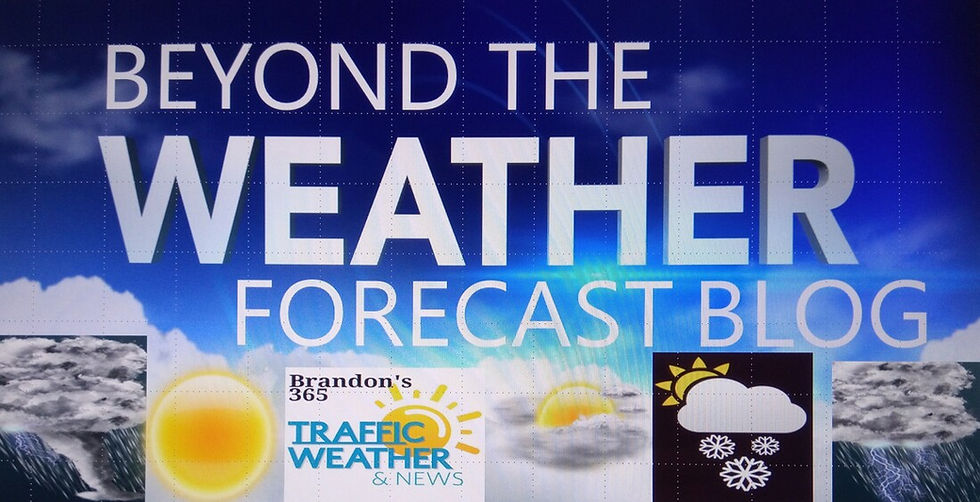Beyond The Forecast: About Advances in Radar and Satellites.
- Brandon Shipp

- Jun 16, 2020
- 4 min read

Weather technology has come a long way through the years. Radar provides important information on where rain or snow is falling and which areas are most impacted by weather. Radar works by sending out radio waves that reflect off particles in the atmosphere, such as raindrops or ice or even insects and dust. By measuring the strength of the waves that return to the radar and how long the round-trip takes, forecasters can see the location and intensity of precipitation. The Doppler radar currently used by the National Weather Service also measures the frequency change in returning waves, which provides the direction and speed at which the precipitation is moving. This key information allows forecasters to see rotation occurring inside thunderstorms before tornadoes form. Looking at several radar images over a period of time can give clues about where and how fast the rain or snow is moving. A loop of several images can also help show if the rain or snow is growing or shrinking in area or if it is becoming more intense.
RADAR THROUGH THE YEARS: In 1975, weather radars used old vacuum tubes, similar to television sets of that era. Today's weather radars operated by the National Weather Service are highly sensitive and include Doppler capabilities. They provide fine resolution measurements of reflectivity and velocity and multiple categories of analysis products. Data and information from these radars allow forecasters to look inside storms and infer wind speed and direction. Additionally, an upgrade to dual polarization products in all National Weather Service radars in 2012-2015 allows forecasters to better determine atmospheric target type, size and diversity. These new dual polarization capabilities allow forecasters to better identify precipitation type, which ultimately helps with winter weather forecasting and hail detection, improves precipitation estimation, filters out non-meteorogical targets so forecasters can only focus on meteorological phenomena, and identifies airborne debris which can assist in locating tornadoes. In 1975, the radar meteorologist had to manually trace the outline of rain and snow areas on an overlay to see where it was. Today's radars use geographic information systems (GIS) to allow for quick identification of storms and rain or snow areas near various cities or towns, parks, rivers, and highways. Radar data today can also be merged with other data types such as satellite cloud top temperatures and lightning strikes to determine the trend of a storm and to estimate rainfall rates and hail size within the storm.
A NETWORK OF RADARS:
After the discovery of the hook echo in 1953, the first successful tornado prediction in 1956, the United States built and deployed a network of weather radars across the US in the late 1950s to detect precipitation. This radar network was upgraded in the 1980s with the next‐generation radar network, called NEXRAD. Now, in the United States, the eastern US has the best radar coverage, with most locations scanned by several radars at once. Radar coverage in the western United States is challenging due to mountains blocking the radar beams. As a result, the radar network’s ability to monitor precipitation, intensity, and amount in the West is much more limited. The ideal scanning strategy to measure precipitation is to scan really low in the sky as possible. Mountains make this very, very difficult.
ADVANCED SATELLITES: New Satellites have became operational and also help to track all different types of active weather. The satellites, named GOES-16 and GOES-17, became operational in December 2017 and February 2019 respectively. Now known as GOES-East and GOES-West, these advanced satellites serve as the two main sources of satellite imagery for not only the U.S. but nearly the entire Western Hemisphere. Both GOES-16 and GOES-17 provide numerous improvements over their nearly decade-old predecessors. These new satellites have three times more spectral information, four times more spatial resolution and five times faster coverage than their predecessors. That means that in five minutes, these new satellites can scan nearly the entire hemisphere, providing an image in 16 different channels with a resolution down to less than one half of a mile. In addition, both GOES-16 and GOES-17 have lightning detectors on board, allowing them to detect lightning strikes from space, something previous satellites lacked the instrumentation to do. Modern day Satellite images are now more detailed and more representative of the current situation given the faster update times. Prior to GOES-16 and GOES-17, confidence in such a designation was much less. Similarly, the difference between a deep snowpack with clear skies and widespread low clouds, two phenomena that look similar on traditional satellite channels, is very easily discernible using the new suite of satellites. Recent improvements in weather radar and satellites have given meteorologists the ability to survey the present state of the atmosphere in ways that were unheard of 20 years ago. These advances, combined with the ever-present surface observations, allow forecasters to accurately diagnose the present weather conditions while also significantly helping the near-term forecast. As technology continues to evolve, additional advances in weather technology, both from the diagnosis and forecast sides of the spectrum, are nearly certain. The GOES Satellites can also detect fires. We are so blessed to have such great technology to track the weather. My personal favorites are the GOES Satellites and 3D Radar Volume scans.







Comments